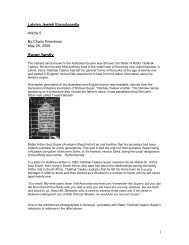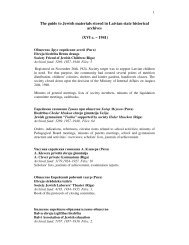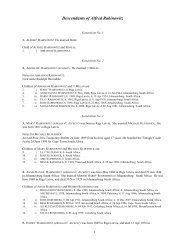Small Riga Ghetto
Small Riga Ghetto
Small Riga Ghetto
You also want an ePaper? Increase the reach of your titles
YUMPU automatically turns print PDFs into web optimized ePapers that Google loves.
54<br />
In one single outpatient clinic, the physician Dr. Josef tried with all his<br />
might to alleviate our sufferings. During the ghetto's short lifespan our doctors<br />
performed virtually superhuman feats. Because there was no room in the clinic<br />
for all the patients, they treated other patients at home, voluntarily and free of<br />
charge. One could see Dr. Mintz and Dr. Kostia Feiertag going to visit their<br />
patients day and night. And the other doctors were no less committed.<br />
There were plenty of medicines in the Large <strong>Ghetto</strong>. Every individual had<br />
supplies of medicine, and besides, the ghetto did not exist for very long, so the<br />
supplies were sufficient.<br />
After the first few weeks it became obvious that the sanitation conditions<br />
were catastrophic. The city government refused to pick up any kind of refuse.<br />
Thus we were forced to dig huge pits in the courtyards so that garbage and<br />
other refuse could be disposed of. The result was that, although it was winter,<br />
the air was heavy, bad and polluted. If the ghetto had existed any longer, an<br />
epidemic would inevitably have broken out. Probably this was our enemies'<br />
ultimate goal!<br />
V.<br />
In the early morning hours, while it was still dark, the work crews had to assemble<br />
in Sadovnika Street and some of the side streets. From there they<br />
marched, accompanied by the Kolonnenfuehrer (leader) of their respective<br />
Kommandos, to do the tasks assigned to them. The largest Kommandos, which<br />
I will report on later, were those assigned to the Field Headquarters, the Billeting<br />
Department, the Gestapo, HVL, Knights' Hall, the Army Vehicle Park<br />
(HKP) and many others.<br />
Besides these Kommandos, many people also worked in the ghetto itself. Before<br />
the ghetto was closed, a large Kommando was sent to Jumpravmuiža to<br />
build barracks for the new arrivals (see the chapter on Jumpravmuiža).<br />
The intelligentsia among the Jewish women set up a large ghetto laundry, in<br />
which people worked very hard. Mrs. Singel, Mrs. Trubek and others worked<br />
here under the guidance of the wife of Dr. Eljaschow the lawyer.<br />
Over time, even a Technical Authority was set up. Its first task was an attempt<br />
to set up a public bath. In the meantime, the committee was very busy<br />
setting up certain training courses. I too submitted a project for training workers<br />
to do weaving both by hand and with mechanical looms. I also wanted to<br />
set up an adjoining knitting workshop. I proposed that the engineer Ilia<br />
Galpern (of the textile factory) be the technical director. Because of the short<br />
lifespan of the ghetto, none of these many plans could be implemented.










